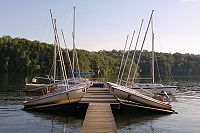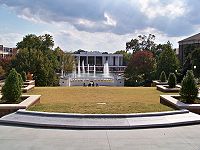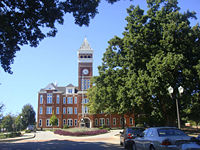Pictures of our Landscapes Clemson Group 4: Difference between revisions
| Line 12: | Line 12: | ||
=== Description === | === Description === | ||
The first image provided shows Lake Hartwell from Clemson University Beach and Recreation Area. The beach and recreation area provide a contras to lush surrounding forestry and downtown campus area. The lake also provides a relaxing back drop to the historic architectural school buildings. It promotes a healthy lifestyle for the students and residents of the city through its many available outdoor recreational activities. The landscape of Clemson and the surrounding area is well defined by water. The region is home to multiple lakes implemented by the Army Core of Engineers for flood control, hydroelectric energy, and as a navigation project. Today the man-made lake is one of the largest in the Southeast United States and provides an incredible area for boating, fishing, and camping. The dam and lake were constructed between 1955 and 1963. Today it is currently one of the most visited Army Corps of Engineers lakes in the country. | |||
The second image selected is a view from Carillon Garden looking down toward the University’s main library. It stands in the center of campus and acts as one of the centralized focus points welcoming visitors with its sprawling vista. As the elevation changes to a lower level the view opens showing the rolling garden, an outdoor amphitheatre, and the main campus library. Recently the garden has been redesigned to create a more dramatic change in elevation allowing users to have a more expressive experience. The garden was a gift from the Class of 1947. As the garden rolls out it changes into a shared mixed materials amphitheatre area. This is a design solution to move the softscape lawn area into the hardscape area of campus. The amphitheater was a gift of the University’s Class of 1915. It provides a space for students to relax outdoor, study, and enjoy the elements of nature while still being in direct connection to campus. The amphitheater seats 2,500 spectators on its marble and turf seating area, and allows for 5,000 more to sit on the hillside facing the stage. Nestled between the amphitheatre and the library is a large reflecting pool and fountain. The large pool creates a soft and relaxing feel as the white concrete main library stands mirroring its image doubling in stature. Cooper Library was completed and opened for use in 1966. It features a stark contrast to many of the older, historic building found on campus with its modern architectural design. | |||
The third and final picture which we are presenting is an image of the University’s historic Tillman Hall. The building was completed in 1893 and is on the National Register of Historic Places. The tower features a clock which chimes every 15 minutes with a 47-bell carillon. This building is one of the iconic images of the university. Sitting adjacent to the building on the left is the Walter T. Cox Plaza. This area provides space for students to socialize, study, or have lunch outdoors in the well-constructed landscape. This image also reflects the university’s abundance large majestic trees. These oaks provide a welcoming entrance into the University’s core. | |||
[[Category:Pictures of our Landscapes]] | [[Category:Pictures of our Landscapes]] | ||
Latest revision as of 02:57, 26 October 2010
---> Back to overview of groups
Authors: Chris Pay, James Ray, Akshay Badwe, Jingjin Zhong, Shuowei Qin
Images
Description
The first image provided shows Lake Hartwell from Clemson University Beach and Recreation Area. The beach and recreation area provide a contras to lush surrounding forestry and downtown campus area. The lake also provides a relaxing back drop to the historic architectural school buildings. It promotes a healthy lifestyle for the students and residents of the city through its many available outdoor recreational activities. The landscape of Clemson and the surrounding area is well defined by water. The region is home to multiple lakes implemented by the Army Core of Engineers for flood control, hydroelectric energy, and as a navigation project. Today the man-made lake is one of the largest in the Southeast United States and provides an incredible area for boating, fishing, and camping. The dam and lake were constructed between 1955 and 1963. Today it is currently one of the most visited Army Corps of Engineers lakes in the country.
The second image selected is a view from Carillon Garden looking down toward the University’s main library. It stands in the center of campus and acts as one of the centralized focus points welcoming visitors with its sprawling vista. As the elevation changes to a lower level the view opens showing the rolling garden, an outdoor amphitheatre, and the main campus library. Recently the garden has been redesigned to create a more dramatic change in elevation allowing users to have a more expressive experience. The garden was a gift from the Class of 1947. As the garden rolls out it changes into a shared mixed materials amphitheatre area. This is a design solution to move the softscape lawn area into the hardscape area of campus. The amphitheater was a gift of the University’s Class of 1915. It provides a space for students to relax outdoor, study, and enjoy the elements of nature while still being in direct connection to campus. The amphitheater seats 2,500 spectators on its marble and turf seating area, and allows for 5,000 more to sit on the hillside facing the stage. Nestled between the amphitheatre and the library is a large reflecting pool and fountain. The large pool creates a soft and relaxing feel as the white concrete main library stands mirroring its image doubling in stature. Cooper Library was completed and opened for use in 1966. It features a stark contrast to many of the older, historic building found on campus with its modern architectural design.
The third and final picture which we are presenting is an image of the University’s historic Tillman Hall. The building was completed in 1893 and is on the National Register of Historic Places. The tower features a clock which chimes every 15 minutes with a 47-bell carillon. This building is one of the iconic images of the university. Sitting adjacent to the building on the left is the Walter T. Cox Plaza. This area provides space for students to socialize, study, or have lunch outdoors in the well-constructed landscape. This image also reflects the university’s abundance large majestic trees. These oaks provide a welcoming entrance into the University’s core.


